Manure Pits May Fill Faster when Feeding DDGS
When feeding DDGS at the 30-40% level, which is now commonly fed in grow-finish diets, a higher amount of manure volume may mean manure storage time is reduced.

Manure management experts are telling producers to keep an eye on manure pit levels because they may fill up faster when distiller’s dried grains with solubles (DDGS) are fed. University of Minnesota animal scientist Jerry Shurson says swine diets containing the ethanol byproduct have a higher fiber content than traditional corn and soybean meal rations, which increases fecal output.
“When feeding DDGS at the 30-40% level, which is now commonly fed in grow-finish diets, a higher amount of manure volume may mean manure storage time is reduced,” he says.
Larry Jacobson, University of Minnesota agricultural engineer, notes that even though manure output only increases 5-10% with DDGS, the increase is noteworthy for pork producers who only empty manure pits once a year.
Manure composition does not seem to change significantly when feeding DDGS, depending upon other dietary ingredient levels. Shurson says the high protein content relative to lysine can potentially increase nitrogen content in manure, but adding synthetic amino acids helps reduce excess nitrogen in the diet and in the manure.
Phosphorus digestibility is higher when feeding DDGS, so the amount of inorganic phosphorus may be reduced. “Depending on the age of the pig and diet formulation method, we may see a slight reduction in manure phosphorus when feeding DDGS,” Shurson says. Manure potassium levels do not change significantly with DDGS in diets, he adds.
Manure Gases
Limited research has been conducted to determine if feeding diets with DDGS affects gas and odor emissions from swine manure. The level of sulfur in distiller’s grains, combined with amounts of dietary sulfur from other ingredients, such as copper sulfate, may increase hydrogen sulfide gas levels.
Higher fecal nitrogen levels also have the potential to raise the amount of ammonia released. In limited studies, the effects of feeding DDGS have been inconsistent for hydrogen sulfide and ammonia emissions.
Pit Foaming Still Perplexing
Jacobson says increased microbial activity in manure pits when DDGS are fed results in fewer solids and less manure crust formation, which may make agitation and pumping easier. However, the microbial activity may also contribute to the perplexing manure pit foaming problems reported by producers throughout the north-central states in recent years.
But foam production is not a completely new challenge. For years, manure management experts only received a single call per year about manure pit foaming issues. Then, in 2009, manure pit foaming incidents in the Upper Midwest took a significant jump. This caused concern because foam on top of liquid manure in deep pit storage has a higher potential for flash fires or explosions. One southern Minnesota pork producer narrowly escaped serious injury when he was blown nearly 40 ft. out of a building during an explosion in 2009. Several other foam-linked barn explosions and flash fires have occurred in Iowa, Minnesota and Illinois the past two years.
Methane is always produced during anaerobic breakdown of manure. Foam captures this methane and can result in concentrations up to 70%, well above the 5-20% methane explosive range. When the foam bubbles break, a large release of methane occurs inside the barn, and it only takes a spark to set off an explosion, particularly during manure pumping and agitation phases.
Many wonder whether these pit foaming incidents are linked to DDGS in swine diets. “We don’t have hard evidence, but feeding DDGS seems to have the potential to contribute to some of the foaming issues,” Jacobson says. “I want to emphasize that it is not the only cause. Not every person who is feeding DDGS is having a foaming problem. Distiller’s grains may be just one factor when it comes to foaming, but it seems like too much of a coincidence that foaming did not become as big of an issue until we started feeding more DDGS.”
Jacobson is quick to add that the fundamental reasons behind foaming manure pits are not well understood, so more research on pit foaming is needed. “While DDGS seems to be playing a role, there are other factors to investigate, ranging from genetics to management to other ingredients used in the ration,” Jacobson says.
Collaborative research to help understand pit foaming issues is being conducted by the University of Minnesota, University of Illinois, Iowa State University, the University of Nebraska and South Dakota State University.
Lora Berg is a freelance writer from Lakeville, MN.
About the Author(s)
You May Also Like


